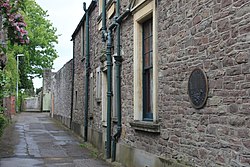The Mynde, Caerleon
| The Mynde | |
| Monmouthshire | |
|---|---|
 The wall of the Mynde | |
| Location | |
| Grid reference: | ST34189053 |
| Location: | 51°36’35"N, 2°57’7"W |
| Village: | Caerleon |
| History | |
| Built 1926 | |
| House | |
| Information | |
The Mynde is a historic house and archaeological site in Caerleon in Monmouthshire. The house is covers 8,100 square feet, built in 1928 in a three and a half acre walled site.[1]
Caerleon is the historic site of the Roman fortress town of Isca Augusta, and the grounds of the Mynde contain some remains from the Roman town.
History
Roman Era
- Main article: Isca Augusta
Caerleon has been settled since AD 75 on the arrival of the Roman legion which established their port and outpost. Elsewhere the town has a number of well preserved Roman sites including Caerleon Amphitheatre, military bath houses, Field Barracks, and the fortress wall, which is 12 feet high.
Local legend associates the site with the burial place of King Arthur, as Nennius in his work Historia Brittonum (c 830) refers to 'The City Of The Legion', believed to be Caerleon.[2]
The Castle of Caerleon is believed to have been established on the site between 1067 and 1075 during the Norman advance from Chepstow into the west.[1]
Chartism and 19th century expansion
Until the 19th Century, the estate had Roman and Mediæval stone ruin, but in 1839 the ruins were removed and the site infilled to construct walls for the present day house, the Mynde. The work was carried out by the then owner, local industrialist John Jenkins, to protect him from Chartist protesters seeking universal male suffrage in Newport. It is believed that extensive remains of a Roman villa were uncovered during the work.[1]
Present day
The site is a special interest site registered by Cadw, and the walls surrounding the land are a Grade II listed structure.[3][4]
A former resident was an eminent local figure Dr Russell Rhys, founder of the Caerleon Arts Festival, and he established the Ffwrwm arts centre opposite the Mynde.[5]
The house was bought in 2016 by the Celtic Manor Resort for use as a retreat and luxury residence.[6]
Outside links
References
- ↑ 1.0 1.1 1.2 'At the Mynde, Pieces of History Are Above Ground': Abigail Saltmarsh in The New York Times June 25, 2015
- ↑ Caerleon – City of the Legion: National Museum Wales
- ↑ Site details: Boundary wall; High Street, No. 15 A;Mynde Cottage (RCAHMW)
- ↑ Garden Wall of The Mynde, Caerleon - British Listed Buildings
- ↑ 'Caerleon doctor and arts patron Russell Rhys, dies': Mike Buckingham in the South Wales Argus, 15 October 2011
- ↑ 'Historic walled home linked to King Arthur snapped up by Celtic Manor Resort as 'exclusive retreat'' South Wales Argus
- 'Yours for £1.95m: The Welsh mansion with iron fort and Chartist defence': Robin Turner on Wales Online 15 November 2013